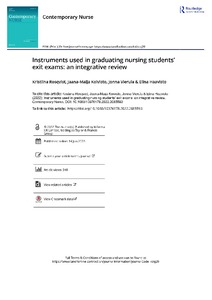Instruments used in graduating nursing students' exit exams: an integrative review
Rosqvist Kristiina; Koivisto Jaana-Maija; Vierula Jonna; Haavisto Elina
https://urn.fi/URN:NBN:fi-fe2022091258525
Tiivistelmä
Background: Worldwide, nursing students comprise a large portion of students in higher education institutions (HEIs). The expectation that HEIs will educate professionally competent nurses is high. To ensure adequate competence, exit examinations play a significant role in evaluation in many countries. However, there has been no comprehensive analysis of the instruments used and the content evaluated in exit examinations globally.
Purposes: The aim of this study was to identify and describe the instruments used in undergraduate nursing students’ exit examinations.
Methods: Five databases were systematically searched, and eleven studies were included. The data of content used in exit exams were analysed using inductive content analysis. The instruments used in exit exams were tabulated and described. The systematic process was followed to identify included papers.
Results: Eleven different instruments were identified, including nine theoretical instruments and two clinical instruments. The exit examinations of undergraduate nursing students varied considerably depending on the country and educational organisation. The content evaluated in the exit examinations covered the holistic nursing perspective.
Conclusions: The findings of this review suggest that HEIs should develop and implement more comprehensive evaluation methods and instruments to ensure students’ competence upon graduation. The results are important for developing exit examinations in nursing education because they indicate that summative evaluation is needed. Clinical examinations have been used marginally in HEIs, which should be considered when implementing new examinations. Digitalisation (e.g. virtual environments) could be one solution for offering objective assessment, validity and cost-effectiveness.
Kokoelmat
- Rinnakkaistallenteet [27094]
